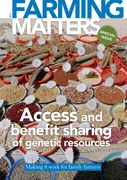In the Ecuadorian provinces of Bolivar, Chimborazo, and Cotopaxi, family farmers are building new capacity to conserve and use the biodiversity on their farms. By participating in action research they gain a greater understanding and control of their plant genetic resources. This results in increased resilience to climatic and other shocks and takes them further on the path towards food sovereignty.
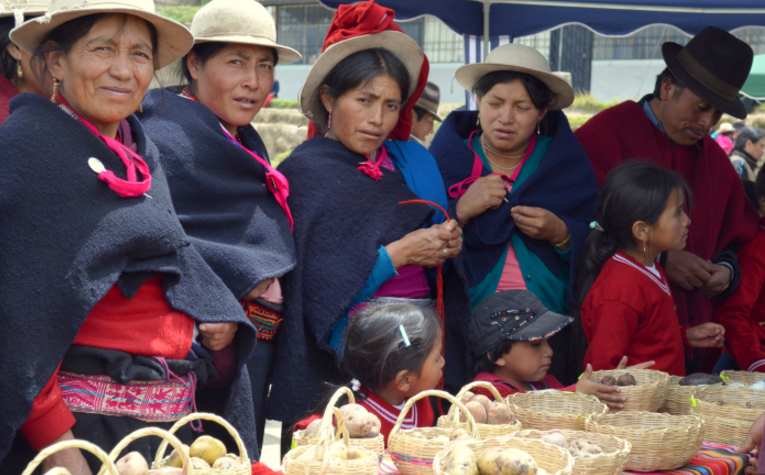
Agrobiodiversity enables rural family farmers to cope with the shocks that are inherent in farming, especially weather, market fluctuations, and pests and diseases. For villages in high altitude and risk prone environments, such as the Ecuadorian Highland Andes, this is very important. In the words of farmer Julio Guano from Naubug village in Chimborazo, “With agrobiodiversity we can produce many different crops. If one does not succeed, others survive, so we don’t lose everything and are able to eat in difficult times.”
Nevertheless, numerous studies in our region provided evidence that on-farm genetic resources have been Giving new life to peasant seeds in Ecuador in sharp decline over the last half-century. Spurred on by these findings, something had to be done.
Farmers as custodians of seeds
Despite owning just 20% of the agricultural resources in Ecuador, smallholder family farms provide more than 70% of the country’s staple foods. Farmers have historically conserved the traditional seeds of staple crops as well as the knowledge of how to use them, which together form the basis of the local system of food production. Smallholder family farmers are the largest supplier of seeds for both improved and local varieties, which are the majority of Andean crops. Modern seed varieties have never constituted more than 1-2% of planting material of Andean crops in Ecuador.
Since the 1960s, agricultural policies that favour monocultures and export led production have neglected smallholder management of genetic resources and weakened the role of the state in improving the knowledge and organisational capacity of small scale farmers. Nonetheless, Ecuador’s current farmer seed system continues to be an extraordinary form of social self-organisation. This system encompasses an extensive network of actors, traditions and institutions that has vigorously resisted the influence of external actors and agricultural policies.
Recently, because of concerns regarding the environmental damage created by industrial agriculture and climate change, politicians, technicians, and academics have started acknowledge small scale agriculture as a solution to these problems. This has resulted in the adoption of the Food Sovereignty Law, which promotes agroecological food production and agrobiodiversity conservation, as well as seed banks. Additionally, governmental institutions were created to develop various aspects of the Food Sovereignty Law, including the Pluricultural Commission for Food Sovereignty (COPISA), which consists of civil society organisations, universities, higher education centers, and governmental organisations. Academics, in turn, have included agroecology as a theme in university curricula and have promoted its mainstreaming in scientific fora and debates. As a result of this increased interest, biodiversity is seen as a critical element for maintaining resilient and dynamic agricultural systems and it is now more widely recognised that small scale farmers play a major role in preserving biodiversity.
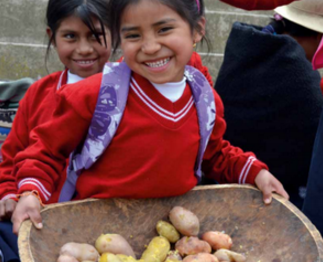
value. Photo: Kaat van Ongeval/ EkoRural
This is evidenced by various developments. In one example, a recent ministerial decree recognises the potential of the small farming sector to produce and market potato seeds – an important economic sector in the Highlands – through the addition of a new category of ‘common seeds circulation’ to its certification al potato varieties have high nutritional value. Over 400 organisations from different sectors (such as the Ministry of Agriculture, national and international research centers such as MAGAP and the International Potato Centre, and various NGOs) have joined forces to call for a focus on mixed or ‘unconventional’(1) seed systems as an alternative to the formal system. Finally, the Agrobiodiversity and Seeds Bill,(2) though still under discussion, likewise recognises the campesino seed and the need to strengthen the informal system with various organisational and institutional initiatives. However, the official policy prioritises the use of certified seeds of bred varieties, and does little to strengthen the farmer seed system.
Researching the roles of biodiversity
For highland villages, which are the greater part of the Andean region of Ecuador, community biodiversity management has evolved as a strategy for on-farm management of genetic resources. Having accompanied this strategy as action research- ers, we consider it key to upholding the resilience of productive systems in the face of climate change and recurring market crises.
In order to characterise the state of these communities’ on-farm agrobiodiversity and locally run seed systems we conducted approximately 800 surveys in more than 30 communities in the central highland provinces of Bolivar, Chimborazo, and Cotopaxi between 2007-2014. Family farmers responded to questions about genetic resources and the function of these seeds in their lives, as well as knowledge and practices tied to the management, availability, access and control of seeds. In addition, we carried out participatory assessments using a variety of tools for community management of agrobiodiversity, including a method called Participatory Four Cell Analysis: in- depth discussion on the destinations of specific crops, their sale, terms of trade, and family consumption. This analysis is designed to measure the relevance and importance of particular crops.
The main objective of this participatory process was to make visible to the community the roles and functions of their seeds, as well as recognising the individuals with outstanding knowledge and capacity to conserve biodiversity. Throughout this process, we encouraged the farmers to start a dialogue about their genetic resources, as it is often felt by them that only when things are expressed and said, they exist.
The process allowed us to track the specific destinations of products, sales, barters and trades, domestic consumption, etc. We found strong evidence of biodiversity loss in communities. Tubers such as mashua (Tropaeolum tuberosum), oca (Oxalis tuberosa), jícama (Pachyrhizus erosus) and melloco (Ullucus tuberosus), had virtually disappeared in local farming systems despite their apparent cultural relevance. This data is very important when considering strategies for the management of agrobiodiversity, particularly when discerning a new role for these crops on farms and in diets. “Seeing as the plants have protected Mother Earth, we too need to shelter the plants and protect them from harm and illnesses. Agrobiodiversity produces crops so that if one does not succeed, others survive, and we don’t lose everything and are able to eat in difficult times.” – Farmer Julio Guamo, Naubug, Chimborazo, 2013
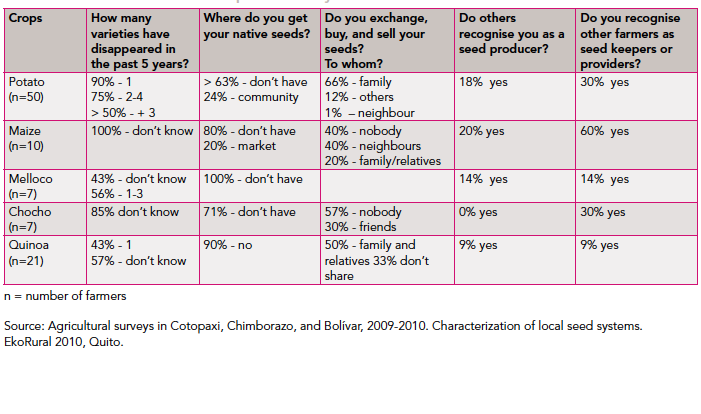
The result of our research (see table) illustrates the systematic loss of community control of biological resources. Chakras (plots) are losing their resilience, jeopardising the future of agriculture and livelihoods (Oyarzun et al. 2011)(3) . However, the table also shows that the participating communities have identified leaders who are passionate about managing plants and seeds. These individuals are statistical outliers who hold tremendous value for the transmission of knowledge about genetic resources and the enhancement of socio-technical innovations.
Following this analysis, community members visualised their multiple relationships with their biological resources and seeds and their livelihood priorities. We assisted local farmer leaders in conducting experimental learning activities with other farmers, as well as promoting seed circulation, botany, and genetics through field days, study tours and farmer to farmer exchanges. As a result of this combination of research and action, communities are now more aware and better equipped to exercise control over their biological resources.
Strengthening control over genetic resources
In the last five years, communities have started to (re)construct, strengthen and expand their own seed banks, which creates stronger ties within families and communities as they are able to circulate and exchange materials and knowledge. In particular, women have gained greater appreciation within their communities thanks to their knowledge and abilities to conserve and improve varieties and seeds. The idea is to create mechanisms of redistribution to protect the seed varieties in question, as well as to generate products for continued circulation. These mechanisms of redistribution create a multipurpose support fund, as well as forming the basis for equitable dissemination of genetic resources among family farmers. There are three supporting mechanisms that operate in seed banks that serve to increase capital and equity. First, of each seed that farmers receive from the bank, they return two seeds after their harvest, meaning a gain of 100% for the bank. Second, each new variety or species which comes into the seed bank is then multiplied and then delivered to the community through the mechanism of ’pass the gift’. Finally, we have agreed with seed officials from research organisations that each species or variety donated to a community should be done through the seed bank. Hence, the local seed bank functions as multipurpose support fund since it protects the seed varieties and generates products for continued circulation. A number of pilot banks successfully operate at present. This success generates curiosity among other neighbouring communities, which are themselves in the process of setting up exchange systems and seed banks. We also identified highly innovative seed guardian families and supported their integration into a support network of likeminded peers. Through contacts with research organisations, they accessed germplasm stored in gene banks, which is especially helpful in recovering lost potato varieties.
Such novel efforts will be at risk without new economic models that recognise the value of local food products. If there is no demand for local food, there will be no use for local seeds. In the last four years we have encouraged a crucial complementary process that connects urban citizens directly with rural producers so that they can access fresh and healthy local food. This stimulates farmers to continue growing a variety of crops using agroecological practices, which in turn reconnects the cultural and political aspects of food. We observe that this is having a very positive impact on health, the environment, and the local economy.
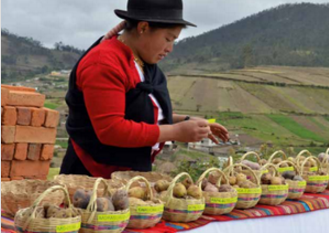
The result has been a slow but steady countermovement against the continued loss of biodiversity in these communities. Several actors, including NGOs, universities, research institutes and local governments have begun to promote the discussion on the value and relevance of conserving and utilising native biodiversity. Urban organisations are actively involved in food sovereignty, agrobiodiversity and seed laws. Their involvement is supported by law: article 8 of the Food Sovereignty Law stipulates that both the state and civil society must promote and protect the use, conservation, and free exchange of native seeds.
ABS in Ecuador
As of this writing there exists no legal framework in Ecuador to regulate intellectual property on seed species. As a consequence, any variety can be used freely and without any restriction or obligatory compensation within the country. However, export oriented bioprospecting (particularly by multinational corporations and international agribusiness) is subject to regulations.
EkoRural has been supporting the capacity building of farmers for seed management by strengthening their skills to value local biodiversity, as well as by identifying the knowledge and motivation of community members who show affinity with seed use and conservation. These participatory inventory practices have been strengthened in pre- and post-storage processes, in-situ seed selection and discovery of aspects of seed physiology such as vigor or germination capacity. Moreover, we support other forms of peasant organisation. This includes the formation of community seed banks in places where seed varieties are locally threatened, as well as mechanisms for the creation of capital such as trading seeds for other seeds, money, labour or community services. These activities have all been important elements in enhancing access and benefit sharing while promoting the capacities and autonomy of family farmers on their path towards food sovereignty.
Both the community members and we researchers feel that this approach needs to be continued and expanded to new crops and territories. The key factor of success in our approach has been to work with, rather than against, local experience, people and knowledge. Everywhere, even under the most difficult conditions of hardship and social marginalisation, there are families that are capable of defending and advancing their own on-farm biodiversity. We find great hope and inspiration in these families. The challenge is in finding ways to strengthen their knowledge and to build links with other likeminded people in order to stand firm against the ongoing threats and mass-marketing of industrial agriculture and industrial foods.
Ross Mary Borja (rborja@ekorural.org) and
Pedro J. Oyarzun (pedro@ekorural.org) work with the EkoRural Foundation in Quito, Ecuador.
Notes
1 Encuentro Regional de Sistemas no convecionales de Semillas. Quito Abril 2012. CIP_ INIAP McKnight Foundation
2 Proyecto de Ley Orgánica de Agrobiodiversidad, Semillas y Fomento Agro-ecológico.
3 Oyarzun, P.J.,Borja, R. M., Sherwood, S. & V. Parra (2013). Making Sense of Agrobiodiversity, Diet, and Intensification of Smallholder Family Farming in the Highland Andes of Ecuador, Ecology of Food and Nutrition, 52:6, 515-541
The authors wish to thank the participating campesino organisations from the Central Highlands, Steve Sherwood, Keely McCaskie, the McKnight Foundation, the Dutch Embassy in Ecuador, the Tidlund Foundation, the Swift Foundation, and the United Nation’s Food and Agriculture Organisation for their contributions. This contribution is adapted from an article first published in Farming Matters (‘Cultivating diversity’, March 2014, www.farmingmatters.org)

